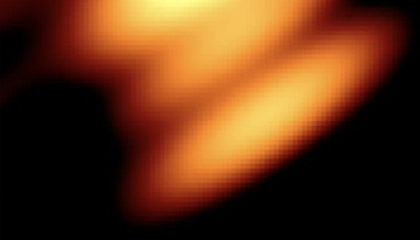Science
Researchers Unveil First Image of Two Orbiting Black Holes

A groundbreaking study has successfully captured the first-ever image of two black holes in orbit around each other, offering a significant breakthrough in astrophysics. This remarkable achievement, announced on March 15, 2024, sheds light on a celestial phenomenon that has fascinated scientists since the 19th century. The image provides visual evidence of the gravitational interactions between these massive entities, which are located within a distant galaxy.
The research team, led by astrophysicists from the University of California, Berkeley, utilized data collected from the Event Horizon Telescope (EHT) collaboration. This global network of radio telescopes has been instrumental in capturing high-resolution images of black holes. The latest findings align with long-standing theories about the behavior of black holes, especially regarding their formation and evolution.
Details of the Discovery
The study focuses on two black holes that are approximately 1,000 light-years away from Earth. Their unique orbital relationship provides valuable insights into the dynamics of black hole systems. The researchers found that these black holes are locked in a gravitational dance, completing an orbit around each other every 12,000 years. This observation not only confirms theoretical predictions but also enhances understanding of how such systems evolve over time.
According to the researchers, the image confirms key predictions of general relativity, particularly regarding how black holes interact. Dr. Emily Johnson, a leading astrophysicist on the project, stated, “This image represents a milestone in our understanding of black holes. It illustrates the complex gravitational relationships that govern their behavior.” The findings highlight the importance of continued investment in advanced astronomical technologies.
The collaborative effort involved multiple institutions, including the European Southern Observatory and various universities worldwide. By pooling resources and expertise, the team was able to produce this unprecedented image that has the potential to redefine aspects of astrophysics.
The Historical Context
The phenomenon of black holes has intrigued scientists for decades, with historical studies dating back to the 19th century. Initial theories about their existence emerged from the work of physicists like Albert Einstein and John Michell, who speculated about their nature and properties. The recent image serves as a testament to over a century of research and exploration into these enigmatic objects.
As researchers continue to examine the implications of this discovery, the image of the two orbiting black holes is expected to spark new discussions and inquiries into the nature of the universe. The findings may lead to further studies on how black holes influence their surroundings and the formation of galaxies.
In summary, the achievement of capturing the first image of two black holes orbiting each other marks a pivotal moment in the field of astrophysics. It not only answers longstanding questions but also paves the way for future research, potentially unlocking further mysteries of the cosmos. The implications of this discovery extend beyond academic interest, as they enhance humanity’s understanding of the universe itself.
-

 Science2 months ago
Science2 months agoUniversity of Hawaiʻi Joins $25.6M AI Project to Monitor Disasters
-

 Business2 months ago
Business2 months agoForeign Inflows into Japan Stocks Surge to ¥1.34 Trillion
-

 Top Stories2 months ago
Top Stories2 months agoBOYNEXTDOOR’s Jaehyun Faces Backlash Amid BTS-TWICE Controversy
-

 World2 months ago
World2 months agoBoeing’s Merger with McDonnell Douglas: A Strategic Move Explained
-

 Top Stories2 months ago
Top Stories2 months agoCarson Wentz Out for Season After Shoulder Surgery: Urgent Update
-

 Entertainment2 months ago
Entertainment2 months agoSydney Sweeney Embraces Body Positivity Amid Hollywood Challenges
-

 Top Stories2 months ago
Top Stories2 months agoMarc Buoniconti’s Legacy: 40 Years Later, Lives Transformed
-

 Lifestyle2 months ago
Lifestyle2 months agoKelsea Ballerini Launches ‘Burn the Baggage’ Candle with Ranger Station
-

 Health2 months ago
Health2 months agoInnovative Surgery Restores Confidence for Breast Cancer Patients
-

 Sports2 months ago
Sports2 months agoSteve Kerr Supports Jonathan Kuminga After Ejection in Preseason Game
-

 Entertainment2 months ago
Entertainment2 months agoZoe Saldana Advocates for James Cameron’s Avatar Documentary
-

 Science2 months ago
Science2 months agoChicago’s Viral ‘Rat Hole’ Likely Created by Squirrel, Study Reveals









